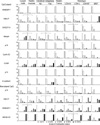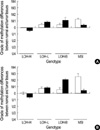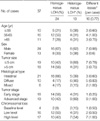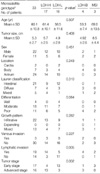Abstract
Figures and Tables
 | Fig. 1Representative autoradiographs of the multifocal microsatellite and methylation analyses. (A) Case 10 shows a high-frequency microsatellite instability (MSI) at more than 40% of the 15 homozygous markers in the three tumor sites (T1, 67%; T2, 73%; T3, 80%). Case 25 had a high-level loss of heterozygosity (LOH) involving chromosomes 3p, 4p, 5q, 9p, 13q, 17p, and 18q commonly shared by the three tumor sites. Normal (N) and the corresponding tumor (T) DNAs are indicated above each allelic band. The asterisk indicates a MSI or LOH. (B) Normal lymph node (LN), nontumoral gastric mucosa (N), and multiple tumor sites (T1, T2, and T3) have a broad range of methylated and unmethylated amplification from the bisulfite-modified DNAs. The lanes marked by U and M indicate the PCR bands of the unmethylation and methylation primer sets, respectively. The methylated and unmethylated proportion of the Maspin CpG islands and the RABGEF1 non-island CpGs was obviously different between the normal lymph node and the gastric mucosa of case 10 and 25. Case 10 with a MSI shows diverse increases in the methylated proportion of the CpG islands of the hMLH1, Maspin, p16, and Cyclin D2 genes as well as the non-island CpGs of the hMLH1 and RABGEF1 genes. In case 25 with a high-level chromosomal loss, the unmethylated proportion of the CpG islands of the Maspin and CAGE genes and the non-island CpGs of the hMLH1, RABGEF1 and MAGE-A2 genes are increased in a similar or dissimilar grade. The percentage of methylated CpGs in the template DNA calculated based on the standard MSP curve (Fig. 2) is indicated below the lanes. The results of microsatellite and methylation analyses are summarized in Tables 2 and 5, respectively. |
 | Fig. 2Standard curves for the methylated and unmethylated MSP amplification. The genomic DNA universally methylated by DNA methylase and the genome-wide-PCR DNA amplified by a universal primer were used as the positive controls for the methylation and unmethylation DNAs, respectively. The variable mixtures of the two opposite control DNAs based on their PCR intensity of 20 ng/µL were amplified using a set of MSP primers. The band intensities of the methylation (M, closed circle) and unmethylation (U, open circle) primer sets for the CpG islands of the hMLH1 (A), Maspin (B), and CAGE (C) genes and the non-island CpGs of hMLH1 gene (D) are plotted along with the relative proportion against the total band intensity. The amplification intensity ratio of each primer set is linearly increased with the increasing percentage of the corresponding control DNA in the MSP template-primer mixtures. The methylation-unmethylation proportion of the template DNA was distinguished into five grades (0-20% methylation, 21-40% methylation, 41-60% methylation, 61-80% methylation, and 81-100% methylation) based on the reciprocal curves of the methylation and unmethylation bands. The band intensity ratio of each MSP primer set is listed in Table 1. |
 | Fig. 3Methylation profiles of the CpG islands and non-island CpGs in the nontumoral and tumoral tissues. The nontumoral gastric mucosa is grouped according to the presence and absence of the intestinal metaplasia. The tumor tissues are grouped into four microsatellite genotypes. The classification of the microsatellite genotypes is detailed in the "Materials and Methods" section. The CpG methylation status in each tissue group is given as a percentage of five grades. The p-value was calculated using the Mann-Whitney U test. There were *significant differences in methylation density between the lymph node and gastric mucosa, between the presence and absence of intestinal metaplasia, and between the LOH-H and LOH-L groups. The heterogeneous tumor sites showed significant †decreased methylation and ‡increased methylation density compared with the gastric mucosa. §Statistical comparison was not shown due to the small number of LOH-B and MSI cases. All p-values are listed in the Table 7. |
 | Fig. 4Methylation heterogeneity on gastric carcinomas detected by multifocal analysis. The methylation status of the 13 CpG regions is detailed in Table 6. (A) The grade and pattern of the methylation differences in a given CpG region in different tumor sites from a given gastric carcinoma were compared. (B) The methylation differences detected in individual tumor sites are shown separately according to the grade of the methylation differences. (C) The grades of the methylation differences given as percentage were compared between different tumor-cell-content groups. The differences in the methylated-unmethylated proportion between the paired normal and heterogeneous tumor sites were graded U1-U4 decreased methylation differences and M1-M4 increased methylation differences. |
 | Fig. 5Heterogeneous methylation profiles of the p16, hMLH1, and MAGE-A2 CpG regions. PCR products common for methylated and unmethylated CpGs were cloned and ten clones were randomly selected. The individual and pooled clones were amplified by the MSP primer sets (A). The individual PCR clones generated heterogeneous methylation densities in the MSP analysis. The pooled PCR clones showed similar MSP patterns with those of the corresponding genomic DNAs listed in Table 6. Five PCR clones from each genomic DNA generating different or no MSP band intensities were sequenced (B). PCR primers specific for the unmethylation ( ) and methylation (▬), and common (▭) for the methylation and unmethylation are indicated by the horizontal bars below the vertical lines marking the individual CpG sites. Individual CpG sites of each PCR clone are indicated as circles in a clone-numbered row. A closed circle marks a methylated CpG and an open circle marks an unmethylated CpG. The methylation composition of the PCR clones was heterogeneous in similarity with a broad range of methylated and unmethylated band intensities. One or two primer-template sequence mismatches produced weak band intensities. Multiple sequence mismatches in the primer regions of the hMLH1 CpG islands (normal clone 6 and tumor clone 4 in case 43) produced none of the methylation and unmethylation bands. |
 | Fig. 6Pattern of methylation differences in the CpG island (□) and non-island CpG (■) area of the p16 (A) and hMLH1 (B) genes. The gastric carcinoma was classified as four microsatellite genotypes. The classification of the microsatellite genotypes is detailed in the "Materials and Methods" section. The decreased methylation differences in the LOH-H cases and the increased methylation differences in the LOH-L, LOH-B, and MSI cases were observed in the methylation gradient region between the CpG islands and non-island CpG area of the same gene. The increased methylation (M1-4) and decreased methylation (U1-4) differences are indicated by a difference in methylation grade between the gastric mucosa and the gastric carcinoma. The bar and error bar represents the mean and SEM of the methylation grade difference. |
 | Fig. 7Schematic illustration of the CpG methylation status dislodged dependent on the extent of chromosomal losses. A methylation gradient between the undermethylated CpG-rich promoter region (CpG island) and the overmethylated CpG-poor region (non-island CpG) is prone to both hypo- and hypermethylation. The high-level (LOH-H) and low-level (LOH-L) chromosomal losses stimulate the variable hypomethylation in the methylation-gradient regions via dosage-compensation mechanism. Significant hypomethylation in the LOH-H cases demethylate the initial hypermethylation, leading to few hypermethylation. Meanwhile, the LOH-L cases are under the influence of low-grade hypomethylation and retain the initial methylation changes. |
Table 1

*The genomic positions were calculated from the July 2003 human genome reference sequence. *The relative proportion of the unmethylation (U) and methylation (M) primer sets against the total band intensity. The nucleotide sequences and PCR condition of each primer set are provided in the Table 2.
Table 3

*The classification of the microsatellite genotype is detailed in the "Materials and Methods" section. Each rectangle is divided into three parts (▥) indicating three tumor sites, T1, T2, and T3. ▮ constitutional chromosomal loss involving more than one microsatellite marker, interstitial chromosomal loss involving one microsatellite marker, reciprocal loss of upper and lower allele, ⊠positive for microsatellite instability, ▯ negative for a loss of heterozygosity.
Table 4





 PDF
PDF ePub
ePub Citation
Citation Print
Print







 XML Download
XML Download